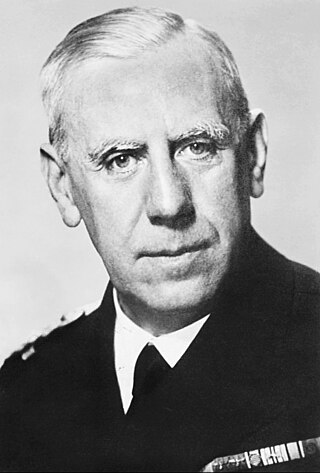
Wilhelm Franz Canaris was a German admiral and the chief of the Abwehr from 1935 to 1944. Canaris was initially a supporter of Adolf Hitler, and the Nazi regime. Following the German invasion of Poland in 1939, however, Canaris turned against Hitler and committed acts of both passive and active resistance during the war.

Otto Johann Anton Skorzeny was an Austrian-born German SS-Obersturmbannführer in the Waffen-SS during World War II. During the war, he was involved in a number of operations, including the removal from power of Hungarian Regent Miklós Horthy and the Gran Sasso raid which rescued Benito Mussolini from captivity. Skorzeny led Operation Greif in which German soldiers infiltrated Allied lines wearing their enemies' uniforms. As a result, he was charged in 1947 at the Dachau Military Tribunal with breaching the 1907 Hague Convention, but was acquitted.
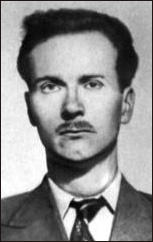
John Cairncross was a British civil servant who became an intelligence officer and spy during the Second World War. As a Soviet double agent, he passed to the Soviet Union the raw Tunny decryptions that influenced the Battle of Kursk. He was alleged to be the fifth member of the Cambridge Five. He was also notable as a translator, literary scholar and writer of non-fiction.
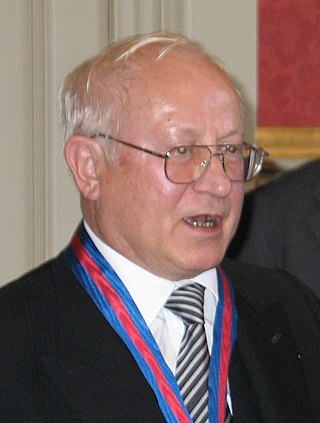
Oleg Antonovich Gordievsky, CMG is a former colonel of the KGB who became KGB resident-designate (rezident) and bureau chief in London. He was a double agent, providing information to the British Secret Intelligence Service (MI6) from 1974 to 1985. After being recalled to Moscow under suspicion, he was exfiltrated from the Soviet Union in July 1985 under a plan code-named Operation Pimlico. The Soviet Union subsequently sentenced him to death in absentia.

SMERSH was an umbrella organization for three independent counter-intelligence agencies in the Red Army formed in late 1942 or even earlier, but officially announced only on 14 April 1943. The name SMERSH was coined by Joseph Stalin. The formal justification for its creation was to subvert German attempts to infiltrate the Red Army on the Eastern Front.

The Red Orchestra, as it was known in Germany, was the name given by the Abwehr Section III.F to anti-Nazi resistance workers in August 1941. It primarily referred to a loose network of resistance groups, connected through personal contacts, uniting hundreds of opponents of the Nazi regime. These included groups of friends who held discussions that were centred on Harro Schulze-Boysen, Adam Kuckhoff and Arvid Harnack in Berlin, alongside many others. They printed and distributed prohibited leaflets, posters, and stickers, hoping to incite civil disobedience. They aided Jews and resistance to escape the regime, documented the atrocities of the Nazis, and transmitted military intelligence to the Allies. Contrary to legend, the Red Orchestra was neither directed by Soviet communists nor under a single leadership. It was a network of groups and individuals, often operating independently. To date, about 400 members are known by name.

Crypto AG was a Swiss company specialising in communications and information security founded by Boris Hagelin in 1952. The company was secretly purchased for US $5.75 million and jointly owned by the American Central Intelligence Agency (CIA) and West German Federal Intelligence Service (BND) from 1970 until about 1993, with the CIA continuing as sole owner until about 2018. The mission of breaking encrypted communication using a secretly owned company was known as "Operation Rubikon". With headquarters in Steinhausen, the company was a long-established manufacturer of encryption machines and a wide variety of cipher devices.
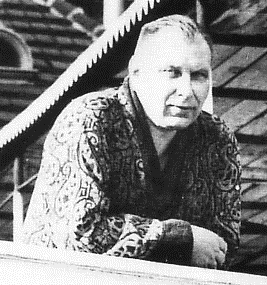
Hans-Thilo Schmidt codenamed Asché or Source D, was a spy who sold secrets about the German Enigma machine to the French during World War II. The materials he provided facilitated Polish mathematician Marian Rejewski's reconstruction of the wiring in the Enigma's rotors and reflector; thereafter the Poles were able to read a large proportion of Enigma-enciphered traffic.
In World War II espionage, the Lucy spy ring was an anti-Nazi operation that was headquartered in Switzerland. It was run by Rudolf Roessler, a German refugee and ostensibly the proprietor of a small publishing firm, Vita Nova. Very little is clear about the Lucy ring, about Roessler, or about Lucy's sources or motives.

Rudolf Roessler was a Protestant German and dedicated anti-Nazi. During the interwar period, Roessler was a lively cultural journalist, with a focus on theatre. In 1933 while a refugee, he moved to Switzerland and established a small publishing firm in Lucerne known as Vita Nova that published works of exiled writers. Late in the summer of 1942, Roessler ran the Lucy spy ring, an anti-Nazi Soviet espionage operation that was part of the Rote Drei while working for Rachel Dübendorfer through the cut-out Christian Schneider (editor). Roessler was able to provide a great quantity of high-quality intelligence, around 12,000 typed pages, sourced from the German High Command of planned operations on the Eastern Front, usually within a day of operational decisions being made. Later in the war, Roessler was able to provide the Soviet Union with intelligence on the V-1 and V-2 missiles. During the Cold War, Roessler reactivated his network and spied on NATO countries in Western Europe under orders from the military intelligence services of the Czechoslovak Republic, until he was arrested by the Swiss authorities and convicted of espionage in 1953.

Alexander Allan Foote was a radio operator for a Soviet espionage ring in Switzerland during World War II. Foote was born in Liverpool, and raised mostly in Yorkshire by his Scottish born father and English mother.

Reinhard Gehlen was a German career intelligence officer who served the Weimar Republic, Nazi Germany, the U.S. intelligence community, and the NATO-affiliated Federal Republic of Germany during the Cold War.

Alexander Radó, also: Alex, Alexander Radolfi, Sándor Kálmán Reich or Alexander Rado, was a Hungarian cartographer who later became a Soviet military intelligence-agent in World War II. Radó was also a member of the resistance to Nazi Germany, devoted to the service of the so-called Red Orchestra, the Soviet espionage and spy network in Western Europe between 1933 and 1945. Within the Red Orchestra, he headed the Switzerland-based Red Three group, one of the most efficient components of the Soviet intelligence network.
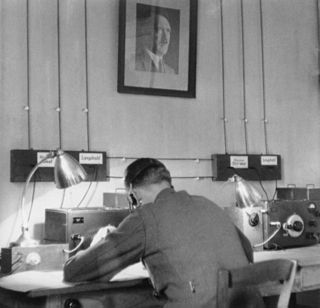
The Abwehr was the German military-intelligence service for the Reichswehr and the Wehrmacht from 1920 to 1945. Although the 1919 Treaty of Versailles prohibited the Weimar Republic from establishing an intelligence organization of their own, they formed an espionage group in 1920 within the Ministry of Defence, calling it the Abwehr. The initial purpose of the Abwehr was defense against foreign espionage: an organizational role that later evolved considerably. Under General Kurt von Schleicher the individual military services' intelligence units were combined and, in 1929, centralized under Schleicher's Ministeramt within the Ministry of Defence, forming the foundation for the more commonly understood manifestation of the Abwehr.
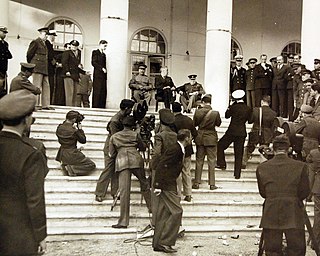
Operation Long Jump was an alleged German plan to simultaneously assassinate Joseph Stalin, Winston Churchill, and Franklin D. Roosevelt, the "Big Three" Allied leaders, at the 1943 Tehran Conference during World War II. The operation in Iran was to be led by SS-Obersturmbannführer Otto Skorzeny of the Waffen SS. A group of agents from the Soviet Union, led by Soviet spy Gevork Vartanian, uncovered the plot before its inception and the mission was never launched. The assassination plan and its disruption have been popularized by the Russian media with appearances in films and novels.

The Secret Intelligence Service (SIS), commonly known as MI6, is the foreign intelligence service of the United Kingdom, tasked mainly with the covert overseas collection and analysis of human intelligence on foreign nationals in support of its Five Eyes partners. SIS is one of the British intelligence agencies and the Chief of the Secret Intelligence Service ("C") is directly accountable to the Foreign Secretary.
The Red Three was the Switzerland section of the so-called Red Orchestra. It was established and maintained by Soviet Military Intelligence Staff Division 4.
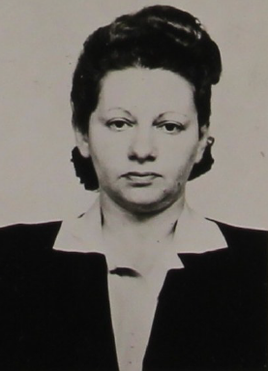
Rachel Dübendorfer was an anti-Nazi resistance fighter. During the Second World War, her codename was Sissy, and she was in a section of the Red Three Swiss resistance movement.
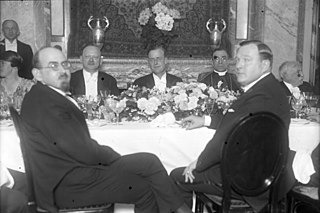
Georges Blun was a French journalist and intelligence agent who was the Berlin correspondent of the Journal de Paris.
Margrit Bolli was a Swiss dancer, better known to students of espionage during the Second World War as a radio operator for the "Red Three", the Swiss branch of the so-called "Red Orchestra". "Red Orchestra" was the umbrella term used by the German security services to identify a widely dispersed network of anti-(German) government resistance activists. The German authorities, and many commentators following their lead, operated according to the simplifying assumption that the entire "Red Orchestra" was a coherent network directed by Soviet intelligence. The reality was a little more nuanced, but many of the most effective resistance activists were indeed committed communists, and many did maintain close links to Moscow. For this, the work of politically engaged radio operators such as Margrit Bolli was vital.

















